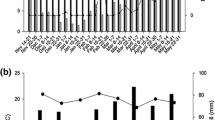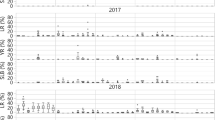Abstract
The use of cultivar mixtures is increasingly practical in wheat stripe rust management. Field experiments with wheat cultivar mixtures were conducted to determine their effects on temporal and spatial patterns of stripe rust epidemics in three regions. In the Beijing and Gangu fields, where the epidemics were caused by artificial inoculation, disease incidence and the area under the disease progress curve (AUDPC) of the cultivar mixtures were significantly lower (P < 0.05) than those of the susceptible pure stands. We defined the relative effectiveness of cultivar mixture on disease development related to that in pure stands (REM). The results demonstrated that in many treatments of mixtures of susceptible cultivar with resistant cultivars at various ratios in different locations, their effects on disease reduction were positive (REM < 1). The reduction of epidemic rate in cultivar mixtures expressed in either early season or late season depended on the initial pattern of disease and cultivar mixture treatments. Semivariograms were used to determine the spatiotemporal patterns of disease in the Gangu field. The spatial analysis showed clear spatial patterns of the disease in all four directions of the fields on susceptible pure stands but not on cultivar mixtures. The results implied that the mechanisms of cultivar mixture on disease management might include the interruption of disease spatial expansion and a physical barrier to pathogen inoculum by resistant cultivars.




Similar content being viewed by others
References
Andrivon, D., Lucas, J. M., & Ellissèche, D. (2003). Development of natural late blight epidemics in pure and mixed plots of potato cultivars with different levels of partial resistance. Plant Pathology, 52, 586–594.
Chin, K. M., & Wolfe, M. S. (1984). The spread of Erysiphe graminis f. sp. hordei in mixtures of barley varieties. Plant Pathology, 33, 89–100.
Cowger, C., & Mundt, C. C. (2002). Effects of wheat cultivar mixtures on epidemic progression of Septoria tritici blotch and pathogenicity of Mycosphaerella graminicola. Phytopathology, 92, 617–623.
Cox, C. M., Garrett, K. A., Bowden, R. L., Fritz, A. K., Dendy, S. P., & Heer, W. F. (2004). Cultivar mixtures for the simultaneous management of multiple diseases: tan spot and leaf rust of wheat. Phytopathology, 94, 961–969.
Didelot, F., Brun, L., & Parisi, L. (2007). Effecta of cultivar mixtures on scab control in apple orchards. Plant Pathology, 56, 1014–1022.
Finckh, M. R., Wolfe, M. S., & van Bueren, E. T. L. (2007). The canon of potato science: 32. Variety mixtures and diversification strategies. Potato Research, 50, 335–339.
Garrett, K. A., & Mundt, C. C. (1999). Epidemiology in mixed host populations. Phytopathology, 89, 984–990.
Garrett, K. A., & Mundt, C. C. (2000). Effects of planting density and the composition of wheat cultivar mixtures on stripe rust: an analysis taking into account limits to the replication of controls. Phytopathology, 90, 1313–1321.
Garrett, K. A., Nelson, R. J., Mundt, C. C., Chacón, G., Jaramillo, R. E., & Forbes, G. A. (2001). The effects of host diversity and other management components on epidemics of potato late blight in the humid highland tropics. Phytopathology, 91, 993–1000.
Li, Z. Q., & Zeng, S. M. (2002). Wheat rusts in China. Beijing: China Agricultural Press.
Liebhold, A. M., Rossi, R. E., & Kemp, R. E. (1993). Geostatistics and geographic information systems in applied insect ecology. Annual Review of Entomology, 38, 303–327.
Madden, L. V., Hughes, G., & van den Bosh, F. (2007). The study of plant disease epidemics. St. Paul: APS Press, American Phytopathological Society.
Mundt, C. C. (2002). Use multiline cultivars and culitvar mixtures for disease management. Annual Review of Phytopathology, 40, 381–410.
Mundt, C. C., & Brophy, L. S. (1988). Influence of number of host genotype units on the effectiveness of host mixtures for disease control: a modeling approach. Phytopathology, 78, 1087–1094.
Mundt, C. C., Brophy, L. S., & Kolar, S. C. (1996). Effect of genotype unit number and spatial arrangement on severity of yellow rust in wheat cultivar mixtures. Plant Pathology, 45, 215–222.
Smithson, J. B., & Lenne, J. M. (1996). Varietal mixtures: a viable strategy for sustainable productivity in subsistence agriculture. Annals of Applied Biology, 128, 127–158.
Wan, A. M., Zhao, Z. H., Chen, X. M., He, Z. H., Jin, S. L., Jia, Q. Z., et al. (2004). Wheat stripe rust epidemic and virulence of Puccinia striiformis f. sp. tritici in China in 2002. Plant Disease, 204(88), 896–904.
Wan, A. M., Chen, X. M., & He, Z. H. (2007). Wheat stripe rust in China. Australian Journal of Agricultural Research, 28, 605–619.
Wolfe, M. S. (1985). The current status and prospects of multilane cultivars and variety mixtures for disease resistance. Annual Review of Phytopathology, 23, 251–273.
Xu, X. M., & Ridout, M. S. (2000). Stochastic simulation of the spread of race-specific and race-nonspecific aerial fungal pathogens in cultivar mixtures. Plant Pathology, 49, 207–218.
Zeng, S. M., & Luo, Y. (2006). Long-distance spread and interregional epidemics of wheat stripe rust in China. Plant Disease, 90, 980–988.
Zeng, S. M., & Luo, Y. (2008). Systems analysis of wheat stripe rust epidemics in China. European Journal of Plant Pathology, 121, 425–438.
Zhu, Y., Chen, H., Fan, J., Wang, Y., Li, Y., Chen, J., et al. (2000). Genetic diversity and disease control in rice. Nature, 406, 718–722.
Zhu, Y., Fang, H., Wang, Y., Fan, J., Yang, S., Mew, T. W., et al. (2005). Panicle blast and canopy moisture in rice cultivar mixtures. Phytopathology, 95, 433–438.
Acknowledgments
This study was supported by the Special Fund for Agro-Scientific Research in the Public Interests (200903035) and the National Natural Science Foundation of China (31071642). The authors gratefully thank Jie-bin Guo and Lei Zhao of China Agricultural University, and She-lin Jin, Man-ku Guo, Ming-an Jin, Shi-qin Cao, and Hui-sheng Luo, Institute of Plant Protection of Gansu province, for their assistance in the field experiments at Gangu. The authors also thank Yue-fu Liu and his colleagues, Yanting Plant Protection Station, for their help with the field trials at Yanting.
Author information
Authors and Affiliations
Corresponding authors
Additional information
Chong Huang and Zhenyu Sun contributed equally to this paper.
Rights and permissions
About this article
Cite this article
Huang, C., Sun, Z., Wang, H. et al. Spatiotemporal effects of cultivar mixtures on wheat stripe rust epidemics. Eur J Plant Pathol 131, 483–496 (2011). https://doi.org/10.1007/s10658-011-9824-0
Accepted:
Published:
Issue Date:
DOI: https://doi.org/10.1007/s10658-011-9824-0




